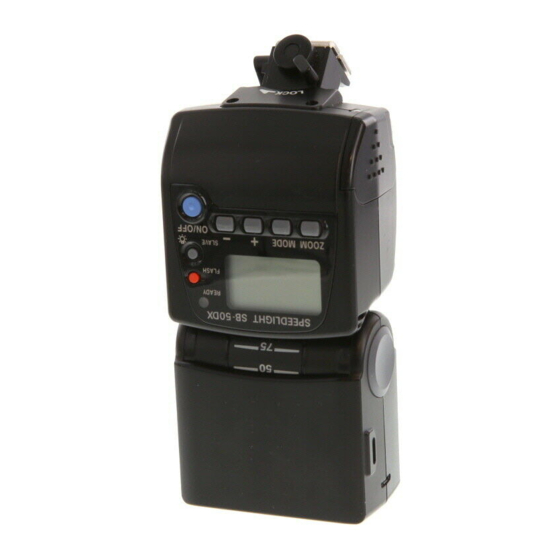Nikon SB-50DX Руководство по эксплуатации - Страница 14
Просмотреть онлайн или скачать pdf Руководство по эксплуатации для Вспышка камеры Nikon SB-50DX. Nikon SB-50DX 39 страниц. Autofocus speedlight
Также для Nikon SB-50DX: Технические характеристики (2 страниц)

Flash Modes and Types of TTL/D-TTL Auto Flash
Available types of TTL auto flash vary depending on the camera/lens/
exposure mode/metering system combination being used. (For details,
see the table on p. 28-29 and your camera's instruction manual.)
• 3D Multi-Sensor Balanced Fill-Flash (with cameras of Group I only) HK
• Information obtained by the Monitor Pre-flashes, exposure control information
and Distance Information from a G- or D-type lens is integrated to
automatically compensate the flash output level for well-balanced exposure on
the main subject and the background.
• You can take well-balanced pictures in very difficult situations, such as a scene
that includes an object with extremely high reflectivity or a subject against an
"infinite" background (empty sky, clouds, etc.).
• Multi-Sensor Balanced Fill-Flash (with cameras of Group I only) HK
• Multi-Sensor Balanced Fill-Flash, without the Distance Information of the 3D
Multi-Sensor Balanced Fill-Flash, can be performed with a combination of the
cameras of Group I and CPU Nikkor lenses other than G/D-type.
• Matrix Balanced Fill-Flash
• Exposure control information obtained by the camera's Matrix meter is used to
automatically compensate the flash output level for well-balanced exposure on
the main subject and the background.
• Center-Weighted Fill-Flash/Spot Fill-Flash
• Exposure control information with Center-Weighted Metering or Spot Metering
is used to properly compensate the flash output for a natural fill-flash effect.
• The exposure balance on the subject and the background may be rather rough
when compared to results obtained with the Matrix Balanced Fill-Flash.
• Standard TTL Flash
• The main subject is correctly exposed.
• Useful when you want to highlight the main subject.
Exposure balance on the main subject and the background
The level of exposure balance on the main subject and the background varies
as the type of TTL auto flash changes. The most well-balanced TTL auto flash is
3D Multi-Sensor Balanced Fill-Flash, the balance control decreases from Multi-
Sensor Balanced Fill-Flash, Matrix Balanced Fill-Flash, Center-Weighted/Spot
Fill-Flash, down to Standard TTL Flash, in that order. (With D-TTL auto flash, it
decreases from 3D Multi-Sensor Balanced Fill-Flash for Digital SLR, Multi-
Sensor Balanced Fill-Flash for Digital SLR, Center-Weighted Fill-Flash for Digital
SLR, down to Standard TTL Flash for Digital SLR, in that order.) Take the level of
exposure balance on the main subject and the background into account when
choosing the camera/lens/exposure mode/metering system combination.
26
—continued
When the SB-50DX is used in TTL auto flash mode with Nikon digital SLR
cameras, D-TTL auto flash mode is automatically activated and Monitor Pre-
flashes become available. Available types of D-TTL auto flash vary
depending on the lens/metering system combination being used. (For
details, see the table on p. 28-29 and your camera's instruction manual.)
• 3D Multi-Sensor Balanced Fill-Flash for Digital SLR
• Information obtained by the Monitor Pre-flashes, exposure control information
and Distance Information from the G- or D-type lens are integrated to
automatically compensate the flash output level for well-balanced exposure on
the subject and the background.
• You can take well-balanced pictures in very difficult situations, such as a scene
that includes an object with extremely high reflectivity or a subject against an
"infinite" background (empty sky, clouds, etc.).
• Multi-Sensor Balanced Fill-Flash for Digital SLR
• Multi-Sensor Balanced Fill-Flash, without the Distance Information of the 3D
Multi-Sensor Balanced Fill-Flash for Digital SLR, can be performed with a CPU
HJ/H
Nikkor lens other than G/D-type.
• Center-Weighted Fill-Flash for Digital SLR
• Exposure control information with Center-Weighted Metering and information
obtained by the Monitor Pre-flashes is used to properly compensate the flash
HJ/H
output for a natural fill-flash effect (with non-CPU lens).
• Standard TTL Flash for Digital SLR
• Exposure control information and information obtained by the Monitor Pre-
flashes is used for correct exposure on the main subject.
• Useful when you want to highlight the main subject.
H
• With Spot Metering, Standard TTL Flash for Digital SLR is automatically activated.
Monitor Pre-flashes
Monitor Pre-flashes are available in Automatic Balanced Fill-Flash with TTL Multi
Sensor (of the TTL auto flash) and all the flash modes in D-TTL auto flash to
determine the condition of the subject.
Just after you depress the shutter release button and before the shutter is
activated, the SB-50DX fires a series of imperceptible pre-flashes that are
detected by the camera's TTL Multi Sensor, and analyzes it for brightness and
contrast. (Monitor Pre-flashes are fired instantaneously and cannot be
differentiated from the main flash.)
Monitor Pre-flashes are not fired when the flash head is tilted up, in Rear-
Curtain Sync (p. 20) or Wireless Flash mode (p. 48) in Automatic Balanced Fill-
Flash with TTL Multi Sensor.
http://www.mynikon.com.pl
HK
D
HK
D
HJ
D
H
D
27
